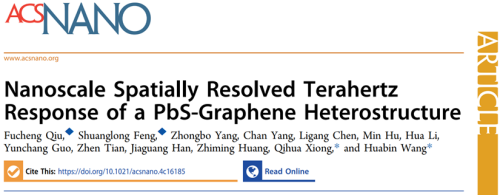

Heterostructures have promising applications in photonics and optoelectronics, mainly due to their high electron mobility and broadband photoresponse covering visible, infrared, and terahertz (THz) ranges. However, it is challenging to detect heterostructures in high definition with conventional THz techniques.
Recently, the Chongqing Institute of Green and Intelligent Technology, Chinese Academy of Sciences (CIGIT, CAS), in collaboration with Tsinghua University and other partners, published a paper in ACS Nano titled “Nanoscale Spatially Resolved Terahertz Response of a PbS-Graphene Heterostructure”. The THz near-field response of PbS-graphene heterostructures at the nanoscale spatial resolution was revealed in this research.

This work demonstrates a THz nanoscopic imaging method which is capable of resolving the local THz response of PbS-graphene heterostructures based upon a sophisticated THz near-field optical microscope. The interaction between the THz near field and the heterostructure is further explored by numerical simulations. The results reveal that both the composition and structure of the layers composing the heterostructure contribute to the THz signal. Furthermore, the team develops a reliably finite dipole model suitable for retrieving THz optoelectronic properties of multilayered systems from measured THz hyperspectra, and realize mapping the local effective permittivity and conductivity of the heterostructure. This study discloses the mechanism of the THz response of heterostructures, and provides a useful method for high-definition quantifying complex THz materials and devices.

Schematic of the research on THz response characteristics of PbS-graphene heterojunctions
Dr. Fucheng Qiu (CIGIT, CAS) and Prof. Shuanglong Feng (CIGIT, CAS) are the first authors, Prof. Huabin Wang (CIGIT, CAS) and Prof. Qihua Xiong (Tsinghua University) are corresponding authors. This work was supported by the National Key Research and Development Program of China, the National Natural Science Foundation of China, the University of Chinese Academy of Sciences Supported Program for Tackling Key Problems in Science and Technology, the Natural Science Foundation of Chongqing.
Link to the related paper: https://pubs.acs.org/doi/10.1021/acsnano.4c16185